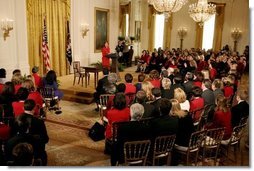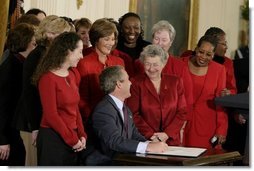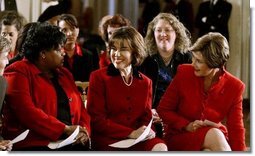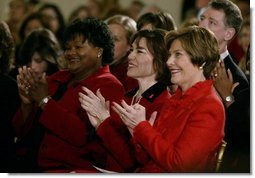|
Home >
News & Policies >
February 2004
|
For Immediate Release
Office of the First Lady
February 2, 2004
Mrs. Bush's Remarks at the Launching of American Heart Month
The East Room
10:26 A.M. EST
MRS. BUSH: Good morning, everybody. Welcome to the White House. I'm so happy you're here. And I'm so happy to see so many people wearing red this morning.
As we kick off American Heart Month, the color red symbolizes our commitment to fight heart disease and to educate every American about the power of prevention. Despite great advances in medicine, cardiovascular disease remains the number one killer of women in America. Nearly 2,600 Americans die from this disease every day, one person every 34 seconds.
 Doctors and researchers provide hope that we can control this
disease. But when it comes to heart disease, very often our health is
in our own hands. Prevention and education can save lives. And that's
why we're here today.
Doctors and researchers provide hope that we can control this
disease. But when it comes to heart disease, very often our health is
in our own hands. Prevention and education can save lives. And that's
why we're here today.
Thanks to the many heart health organizations who are here, who are represented here today, for organizing and championing this issue. And thanks to the physicians and the researchers for advancing treatment. And to the news media and to the fashion industry and to the survivors who have joined us today to promote heart health awareness.
President Bush and I are committed to advancing the health and well-being of every American. In the President's 2005 budget, which was released today, more than $2.4 billion is proposed for the National Institutes of Health. This $65 million increase in the budget will help lead to new and better treatments for heart disease. This is vitally important, as we are all at risk for this disease, especially women.
For the last 20 years, more women than men have died of cardiovascular disease in America. Nearly half a million women die every year. In fact, 65,000 more women will die from cardiovascular disease this year than men.
What's most alarming is that most women don't know this. Many believe that cancer is their greatest concern. Yet heart disease kills more women in our country than all forms of cancer combined. As a mother, as a wife, as a woman, I want to do everything I can to educate other women about their risk for heart disease.
I join with the Heart Truth campaign, sponsored by the National Heart, Lung and Blood Institute and the Department of Health and Human Services, so that we can all spread the word.
The symbol of the Heart Truth is the red dress, which reminds women about their risk and inspires them to take action. Everyone will receive a red dress pin today, and I encourage you to wear this pin along with a red dress or jacket on National Wear Red Day. This Friday, February 6, wear red to work, to the grocery store or to the gym, and tell every woman you can about the dangers of heart disease.
When you wear red on Friday, you're literally joining an army of women who are committed to creating awareness, even when they're a continent away.
 Corporal Tiara Puro is stationed in Baghdad with the Utah Army
National Guard. She read about the Heart Truth campaign, and she was so
inspired by the message that she and the other women in her unit
started eating better and exercising more. And this Friday, they'll
wear red with their uniforms to show that they know the heart truth.
Corporal Tiara Puro is stationed in Baghdad with the Utah Army
National Guard. She read about the Heart Truth campaign, and she was so
inspired by the message that she and the other women in her unit
started eating better and exercising more. And this Friday, they'll
wear red with their uniforms to show that they know the heart truth.
Corporal Puro said, "I want to spread the word about heart health to women here because it's something good that we can do for ourselves as women."
Corporal Puro is right. As wives, as mothers, as daughters and sisters, women often take more time taking care of other people instead of themselves. Oh, we might soak in the bathtub or get a facial, but these are little perks that make us look good on the outside. I'm talking about taking care of our heart by eating healthy food, exercising and visiting the doctor.
Women love to share advice and information with each other. When a coworker tells us about a fat-free recipe for double fudge brownies, we race home and try it. (Laughter.) But if a friend tells us that heart disease is the leading killer of women in America and that we need to get a check-up, we dismiss it and say, oh, I'll go when I have time.
The time to address heart disease is now. Heart disease affects women at every age and can begin developing in our teenage years.
Toni Biffle learned the truth about heart disease after she suffered a heart attack at age 34. I met Toni in Norfolk, Virginia, during an event for the Heart Truth. Two years ago, Toni was rushed to the emergency room after her hands went numb and she began sweating profusely.
Because of her age and because she was a woman, the ER doctor told her she couldn't be having a heart attack. But an EKG test confirmed that she was, and Toni had immediate surgery. Since then, she and her husband have quit smoking and they exercise every day. I'm really glad that Toni is here today.
To reduce our risk for heart disease, we must exercise, eat a healthy diet, quit smoking and get preventive screenings. By leading a healthy lifestyle, women can lower their risk of heart disease by a staggering 82 percent.
We all know we should exercise and we all know the excuses for not doing it. We're too busy or we're too tired or we're too confused about how much is enough. But there's one absolute when it comes to exercise: Any amount is better than none.
Walking is one of my favorite forms of exercise. I love to walk on the trails at Camp David or at our ranch in Crawford. Grab a friend, your children or your dog and go for a walk. With a busy schedule, it's tough to make time for exercise, but I try to walk at least three times a week. And if my mother-in-law, Barbara Bush, can swim 88 laps at a time, the rest of us surely can walk for 30 minutes. (Laughter.)
 You can't strengthen your heart if you continue to smoke. If you
quit today, your risk of heart disease can be reduced up to 50 percent
in one to two years. Exercising and not smoking are great steps to
good health. But this must be combined with a healthy diet. For many
of us, this is truly the hard part. I especially love enchiladas and,
of course, barbecue.
You can't strengthen your heart if you continue to smoke. If you
quit today, your risk of heart disease can be reduced up to 50 percent
in one to two years. Exercising and not smoking are great steps to
good health. But this must be combined with a healthy diet. For many
of us, this is truly the hard part. I especially love enchiladas and,
of course, barbecue.
I used to resolve to lose weight every New Year. But now my resolution is to get and stay healthy. And it's not as simple as it seems, especially when you have a pastry chef whose idea of a light dessert is four layers of chocolate rather than six. (Laughter.)
About 30 percent of heart attacks in women are due to obesity or being overweight. We can avoid junk food by simply not buying it, and we can eat more fruits and vegetables. If I can get my husband to eat broccoli -- (laughter) -- we can all eat an extra serving of vegetables every day.
Exercise and healthy eating will make you feel great, but only a doctor can give you a clean bill of health. I urge you to visit your doctor and learn of your risk factors. Even if you're feeling fine, get your blood pressure and your blood sugar tested and your cholesterol checked. And learn the symptoms associated with a heart attack.
Women often have what's called a silent heart attack, one without symptoms. Studies show that the symptoms women do experience, like fatigue, trouble sleeping and shortness of breath are so common that many women don't realize they're having a heart attack.
Since she was young and healthy, Cathy Porter didn't believe that she was having a heart attack the day before her 45th birthday. I met Cathy while I was talking about heart disease in Kansas City, Missouri. The day of her attack, Cathy passed off the pain in her chest as indigestion. She didn't have tingling in her arm or any of the so-called classic symptoms. But when Cathy was rushed to the hospital, she was treated for a heart attack. She had surgery and is in good health today.
Cathy, thanks for sharing your story.
Preventive screenings, healthy eating and exercise are vital steps we can take to improve our health. But the best preventive medicine is education. A few days after my visit to Kansas City, the doctors sent me an inspiring story about the power of education.
 When Joyce Cullen awoke in the middle of the night with chest pain,
her first thought wasn't a heart attack. But Joyce had watched the
news coverage of my visit to Kansas City, and she had learned the
symptoms of heart disease and realized that she had many of them. She
immediately went to the hospital, where she suffered a heart attack.
She had surgery and is recovering well, and I'm so happy that Joyce is
here today to share her story with all of you.
When Joyce Cullen awoke in the middle of the night with chest pain,
her first thought wasn't a heart attack. But Joyce had watched the
news coverage of my visit to Kansas City, and she had learned the
symptoms of heart disease and realized that she had many of them. She
immediately went to the hospital, where she suffered a heart attack.
She had surgery and is recovering well, and I'm so happy that Joyce is
here today to share her story with all of you.
We must educate ourselves and others about our risk for heart disease and about the steps that we can take to prevent it. Together, we can make a lifesaving difference through education and prevention.
Now, I'd like to introduce Dr. Christina Beato, who is the Acting Assistant Secretary for Health at the Department of Health and Human Services. Dr. Beato is a principal advisor on health policy and she leads the Department's efforts to advance women's heart health. (Applause.)
* * * * *
MRS. BUSH: Thank you all for joining us. We've just been joined by several senators. As a heart and lung surgeon himself, Senator Bill Frist knows the importance of good health. And I'm pleased that he's here with his wife, Karyn, who is wearing her red dress, I noticed also.
Also, thanks to Senator Cochran and Senator Collins and Senator Dorgan for your interest in this cause. I want to thank Dr. Beato and Dr. Hayes for your insight and advice.
And a very special thanks to Joyce for sharing your story. Joyce is proof that informing women about heart disease and educating every American about prevention, we can save lives.
With the many risk factors for heart disease, our greatest risk is ignorance. So I encourage every one of you to go home, pull out your favorite red dress, and tell every woman you know that heart disease doesn't care what you wear. You owe it to your friends and your loved ones and, most important, you owe it to yourself to know the risks for heart disease.
And since everyone in here does now know the risk for heart disease, please share the Heart Truth.
Now, I'd like to introduce a special guest who exemplifies the many good practices we talked about today. He exercises at least five days a week, he has a resting heart rate of 45 beats per minute -- (laughter) -- and his greatest health risk is eating pretzels. (Laughter.)
Ladies and gentlemen, please welcome my husband, President George Bush. (Applause.)
END 10:55 A.M. EST
![]() Printer-Friendly Version
Printer-Friendly Version
![]() Email This Page
Email This Page


